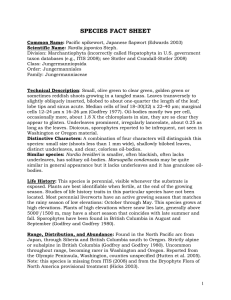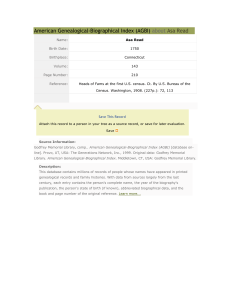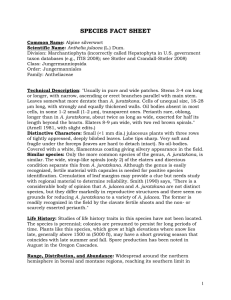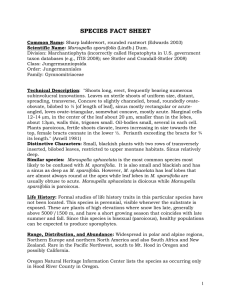SPECIES FACT SHEET
advertisement
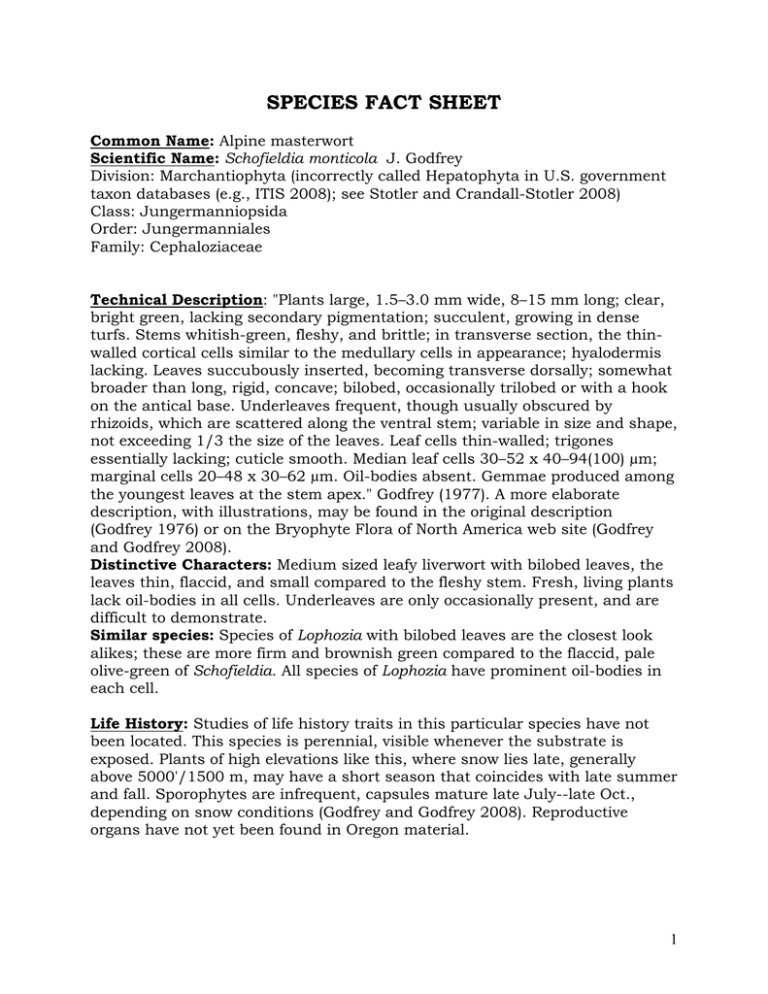
SPECIES FACT SHEET Common Name: Alpine masterwort Scientific Name: Schofieldia monticola J. Godfrey Division: Marchantiophyta (incorrectly called Hepatophyta in U.S. government taxon databases (e.g., ITIS 2008); see Stotler and Crandall-Stotler 2008) Class: Jungermanniopsida Order: Jungermanniales Family: Cephaloziaceae Technical Description: "Plants large, 1.5–3.0 mm wide, 8–15 mm long; clear, bright green, lacking secondary pigmentation; succulent, growing in dense turfs. Stems whitish-green, fleshy, and brittle; in transverse section, the thinwalled cortical cells similar to the medullary cells in appearance; hyalodermis lacking. Leaves succubously inserted, becoming transverse dorsally; somewhat broader than long, rigid, concave; bilobed, occasionally trilobed or with a hook on the antical base. Underleaves frequent, though usually obscured by rhizoids, which are scattered along the ventral stem; variable in size and shape, not exceeding 1/3 the size of the leaves. Leaf cells thin-walled; trigones essentially lacking; cuticle smooth. Median leaf cells 30–52 x 40–94(100) µm; marginal cells 20–48 x 30–62 µm. Oil-bodies absent. Gemmae produced among the youngest leaves at the stem apex." Godfrey (1977). A more elaborate description, with illustrations, may be found in the original description (Godfrey 1976) or on the Bryophyte Flora of North America web site (Godfrey and Godfrey 2008). Distinctive Characters: Medium sized leafy liverwort with bilobed leaves, the leaves thin, flaccid, and small compared to the fleshy stem. Fresh, living plants lack oil-bodies in all cells. Underleaves are only occasionally present, and are difficult to demonstrate. Similar species: Species of Lophozia with bilobed leaves are the closest look alikes; these are more firm and brownish green compared to the flaccid, pale olive-green of Schofieldia. All species of Lophozia have prominent oil-bodies in each cell. Life History: Studies of life history traits in this particular species have not been located. This species is perennial, visible whenever the substrate is exposed. Plants of high elevations like this, where snow lies late, generally above 5000'/1500 m, may have a short season that coincides with late summer and fall. Sporophytes are infrequent, capsules mature late July--late Oct., depending on snow conditions (Godfrey and Godfrey 2008). Reproductive organs have not yet been found in Oregon material. 1 Range, Distribution, and Abundance: Until recently thought to be endemic to the Pacific Northwest, from Alaska south to Oregon, there is a recent paper that reports finding the species in Russia (Bakalin 2005). The plant is scarce in southern Washington and Oregon, with several localities reported from the North Cascades, one from Mount Rainier in Washington (Godfrey 1976) and two sites in Lane County, Oregon (Christy and Wagner 1996, Wagner pers. obs.). BLM: Not to be expected in any district. USFS: Documented in Willamette and Mt. Baker-Snoqualmie National Forests. Suspected in Mt. Hood, Umpqua, and Deschutes National Forests in Oregon and the Olympic, Gifford Pinchot, and Okanogan National Forests in Washington. Habitat Associations: Terrestrial, on peaty soil under heather or beside small streams; strictly subalpine-alpine; with Cassiope, Phyllodoce, and liverworts such as Moerckia. Threats: Recreational developments such as trails and campgrounds could destroy or alter the habitat of this species. Conservation Considerations: For projects in subalpine or alpine areas, such as trail building, which involves disturbing habitat in moist area, consider conducting a careful inventory for species such as Schofieldia monticola. When discovered, consider relocating such projects to reduce or negate impacts to the site/population. Conservation Rankings and Status: Global: G3; Oregon: S1 ORNHIC List 3 Washington: Not ranked Other pertinent information: Surveys and Survey Protocol: Search alpine and subalpine areas, particularly under heather close to streams. Key to Identification of the Species: Christy and Wagner 1996. Preparer: David H. Wagner Edited by: Rob Huff Date Completed: October, 2008 Updated in June 2009 by Candace Fallon (Update added Attachment 1, Photos, to the Species Fact Sheet). 2 ATTACHMENTS: (1) Photos References: Bakalin, V.A. 2005. Schofieldia and Cryptocoleopsis, the new genera of liverworts (Hepaticae) to the flora of Russia. Botaniceskij Žurnal (St. Petersburg) 90: 594-603. [In Russian with English summary. Not seen.] Christy, J.A. & D.H. Wagner. 1996. Guide for the identification of rare, threatened or sensitive bryophytes in the range of the northern spotted owl, western Washington, western Oregon and northwestern California. USDI Bureau of Land Management, Oregon-Washington State Office, Portland. Godfrey, J.D. 1976. Schofieldia, a new hepatic from the Pacific Northwest. The Bryologist 79: 314–320. Godfrey, J.D. and G.A. Godfrey. 1980. Notes on Hepatics from the Pacific Northwest. The Bryologist 83: 224-228. Godfrey, J.D. and G.A. Godfrey. 2008. Schofieldia . Bryophyte Flora of North America, Provisional Publication, Missouri Botanical Garden http://www.mobot.org/plantscience/BFNA/v3/CephSchofieldia.htm Accessed August 2008. ITIS. 2008. Integrated Taxonomic Information System (official government database of scientific names) http://www.itis.gov/index.html Accessed August 2008. Oregon Natural Heritage Information Center. 2007. Rare, threatened and endangered species of Oregon. Oregon Natural Heritage Information Center, Oregon State University. Portland. 100 pp. http://oregonstate.edu/ornhic/2007_t&e_book.pdf Stotler, R.E. and B. Crandall-Stotler. 2008. Correct author citations for some upper rank names of liverworts (Marchantiophyta). Taxon 57: 289-292. 3 Attachment 1 – Photos All photos by Dr. David Wagner, under contract with the Oregon/Washington Bureau of Land Management Shoot Leaf 4 Lobe tip Midleaf cells 5
